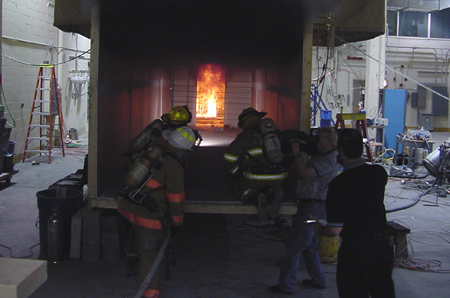Page 3
But
when you have fires burning for six, eight, nine weeks, bunker gear gets
to be pretty cumbersome." The
conference participants offered concrete recommendations to address the
challenges and improve response capabilities.
The apparent tradeoff between the level of protection provided by equipment and the discomfort and physical burden the equipment placed upon those using it was
looked upon as an area in need of R&D. Directing R&D toward advanced respirators, clothing, sensors, and other safety gear may be able to reduce that tradeoff. Other areas suggested by the conference discussions include applications of information technology and communications systems for better management of worker safety at disaster sites and continued emphasis
on technologies for locating responders buried or trapped under rubble. The study points out that technology transfer can help reduce personal protective equipment costs by spreading R&D outlays across a larger user community. It can also speed the introduction of new technologies to the emergency-response community. But the emergency-response community also has special safety needs that may not be adequately met through technology transfer alone.
Many
at the meeting suggested that publicly supported R&D would be
appropriate for addressing the safety needs of emergency responders.
For additional information contact: Dr. Brian Jackson at RAND Science and Technology Policy Institute, (1) + 703-413-1100, ext. 5950, E-mail: Brian_Jackson@rand.org.
Fire Fighters Receive Wireless Alarm Panel Information
NIST’s
Building and Fire Research Laboratory (BFRL) staff and the NIST Fire
Department held a series of full-scale fire tests in the Large Fire
Facility (Building 205) on April 3, 2002.
The purpose was to demonstrate a new standard fire service
interface and incident management information system.
BFRL has been working with the NFPA Technical Correlating Committee
for the National Fire Alarm Code (NFPA
72) to include the fire service interface specification in the 2002
edition of NFPA 72.
A
multi-room structure was built inside Building 205.
Furnishings were placed within the structure, ignited and allowed
to burn to flashover.

NIST researcher Dr. Walter Jones performs final check of laptop computer installed in NIST fire truck.
NIST
firefighters in the station and in the responding vehicle were able to
access real-time information about fire conditions (e.g., temperatures,
visibility, fire size). For
those in the responding truck, information was transmitted to a laptop
computer with a wireless modem installed in the cab.
The prototype fire alarm panel collected the information and
transmitted it in a form that could be viewed as web pages by standard web
browsers on any type of computer (handheld, laptop, desk) or text pager.
All
of the sensor measurements and onsite video coverage from the fire was
available and could be viewed
depending on capabilities of the receiving device.
In addition, information from the sensors was processed using fire
models so that higher-level information such as the heat release rate of
the fire could be displayed.
The wireless display in the apparatus, the terminal in the
mockup in the fire test building all had full access to the information and could query the system independently. As the suppression team entered the structure, their position in the structure was monitored and displayed continuously (the tracking system is being simulated at this point because practical tracking technologies are still under development). Conditions in the structure were monitored in real time and special warnings could have been issued if the system running fire models in parallel determined that the limits of the firefighters’ protective clothing was reached or flashover would occur before suppression could begin.
It
is still an open question as to how the vast amount of fire information
that could be placed in the hands of incident commanders (IC) would be
used. We expect that the more
information that is
available to the IC, the safer and more effective the fire fighting
operation will be. More
discussions with the fire service and demonstrations are planned. Your ideas would be appreciated.
For additional information, contact Walter W. Jones, (1) + 301 975 6887, wwj@nist.gov .

Firefighters enter NIST multi-room fire structure during fire test